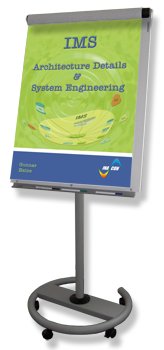 The IP Multimedia Subsystem (IMS) -
The IP Multimedia Subsystem (IMS) -
Architecture Details & System Engineering
[3-day training course, Euro 3,450.- per participant]
 Training Course Description
Training Course Description

- This training course addresses the needs of engineers and technicians who need to understand the very details of the IMS architecture and its interworking with other networks and network entities.
- The training course starts with the definition of the IMS as part of an overall NGN architecture and the description of IMS variations depending on operator type (e.g. fixed telecom, mobile operator, joint operation).
- One chapter is providing an overview of the various protocols that are used within the IMS environment like SIP/SDP and DIAMETER.
- The student is confronted with various practice-oriented questions and exercises to gain the maximum output from the training course.
- Focus of the training course is the extremely detailed analysis of the tasks, functions and operation of the IMS-internal network elements, namely of the different CSCF’s, the MGCF or the MRF.
- This part also discusses the various implementation options like split- and centralized architecture and lines out their pros and cons.
- Another major of the training course is the consideration of the various security threats and issues that an IMS may be suffering from but we also present potential solution strategies to securely address these issues.
- One chapter is dedicated to 3GPP-based mobile networks and the related SIP- and SDP-specifics. In this chapter we also cover the DIAMETER-Protocol and its use within 3GPP-networks.
- Note that this training course represents the architectural and network view of the IMS. A more protocol related training course about the IMS is also available.
Please click here for a detailed Table of Contents (ToC)
Some of your questions that will be answered
- What is the difference between stateful and stateless SIP-proxies, B2BUA’s and SBC’s?
- Can I use private IP-addresses and NAT within the IMS-environment?
- Which identifiers can be used to identify our users?
- How can we allow our users to securely roam to any IP-CAN and still access our IMS?
- How can we protect our IMS from the typical security risks like DoS- or masquerade attacks, spoofing and fraud?
- What are differences among the different IMS-versions like TISPAN and 3GPP?
- Under what circumstances is the implementation of the IMS in split or centralized architecture recommended?
- How can we realize functions like legal interception and IMS based charging?
 Who should attend this class?
Who should attend this class?
- Engineers, technicians and IP-professionals who are involved in the design and engineering of IMS-networks.
- Everybody who requires detailed knowledge about the IMS.
 Pre-Requisites
Pre-Requisites
- The student needs to have a solid background of the IP-protocol stack.
- Previous practical exposure to the design, setup and configuration or operation of SIP-servers or NGN-equipment is favorable.
- The student also needs practical experience with fixed or mobile telecom networks.
 Training Course Target
Training Course Target
- After the training course the student will have a clear understanding of all architecture and network related details of the IMS.
- The student can address all typical questions and issues related to the design, engineering, dimensioning and operation of IMS-enabled networks.
 Training Course Duration
Training Course Duration
- 3 days
v1.2
ℹ️ Try out the updated search below!
Search:
More Info:
Detailed ToC of this training course
Schedule of this training course
Extract of this training course
Buy this book
Buy this book as eBook
INACON eBooks
Please have a look at our full offer

